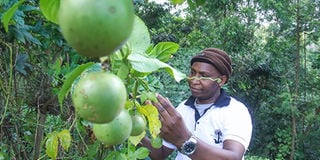Agronomist notebook: What those brown spots say about your passion fruits

Dominous Ndegwa checks on passion fruits that he grows in his home in Tetu, Nyeri County. Brown spots in passion fruits is a disease caused by Alternaria passiflora or Septoria spot and affects leaves, stems and fruits, with the brown spots first appearing on the leaves, which enlarge and develop a lighter-coloured central area and become irregular in shape. PHOTO | JOSEPH KANYI | NATION MEDIA GROUP
What you need to know:
- The fungal disease affects leaves, stems and fruits, with the brown spots first appearing on the leaves, which enlarge and develop a lighter-coloured central area and become irregular in shape.
- Regular pruning of the vines should be done to remove dead, weak vines to allow better air circulation and penetration of fungicide. All the plant debris should be collected and burnt to avoid further spread of the infection.
- Apart from the disease, passion fruit farmers also experience problems such as flower abortion caused by among others poor pollination. This could be due to lack of bees or adequate wind to enable pollination.
- The insects should be controlled by maintaining field hygiene and biological products such as Spical (plus) can be used. Chemicals such as Abamectin also help in controlling the mites.
Carol, a farmer in Kiambu County, sent me some photos from her passion fruit plantation the other day, asking me to help her diagnose the problem and offer solution.
From the pictures, I could tell she had done good management practices like training, weed control and manure application. However, she had not observed correct spacing, one of the things contributing to disease and pest infestation.
The fruits also had conspicuous sunken circular lesions with brown spots that were conspicuous. This was a sign of a disease called Brown spots caused by Alternaria passiflora or Septoria spot.
The fungal disease affects leaves, stems and fruits, with the brown spots first appearing on the leaves, which enlarge and develop a lighter-coloured central area and become irregular in shape.
The ring around the diseased fruits becomes wrinkled and drops. The disease is severe in warm and wet weather conditions.
On the stems, the disease develops elongated dark brown lesions mainly near the leaf axils where the stems have rubbed against the supporting wire.
The disease causes significant loss of yields due to leaf damage and makes the fruits fit for only processing. To prevent the occurrence of the disease, one should plant resistant varieties that are not easily affected.
For instance, yellow passion fruits are more tolerant compared to the purple variety.
Observe the inter-row and intercrop distance to allow proper air circulation and quick drying of the leaves. The appropriate spacing should be 3m by 2m.
Regular pruning of the vines should be done to remove dead, weak vines to allow better air circulation and penetration of fungicide. All the plant debris should be collected and burnt to avoid further spread of the infection.
ENABLE POLLINATION
Maintain the nutritional status of the crop through fertiliser application to ensure that the crop has adequate nutrients.
Chemicals with active ingredients Mancozeb and copper-based fungicides can be used to control the disease.
Apart from the disease, passion fruit farmers also experience problems such as flower abortion caused by among others poor pollination. This could be due to lack of bees or adequate wind to enable pollination.
However, one may do human-induced pollination by shaking the plant a little bit and gently.
Boron deficiency also results in flower abortion, and hence the need to ensure fertiliser application is well-managed so that all the micronutrients are included in the nutrition of the crop.
Thrips, the tiny slender insects, should be controlled as this infest and feed on the flower causing them to drop.
In some cases, fruits abort due to irregular watering or due to fungal infections. Mite infestation can also result in fruit drop.
The insects should be controlled by maintaining field hygiene and biological products such as Spical (plus) can be used. Chemicals such as Abamectin also help in controlling the mites.
Sometimes one gets fruits that produce little juice. This is normally due to inadequate water and nutrients during the growing period.
It’s therefore essential to ensure the soil is moist by providing adequate water to the plant. Passion fruits are usually ready for harvest after six and eight months, with the peak being in the 18th month after transplanting, depending on the variety.
The purple variety can be harvested while still attached to the plant unlike the yellow one, which is best harvested when the fruits fall on the ground. Yellow passion fruit is most preferred for processing of juice since it’s juicier.





